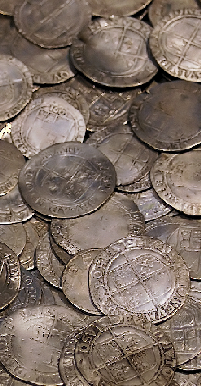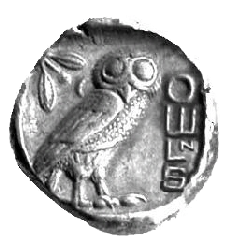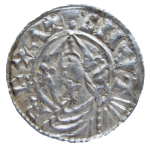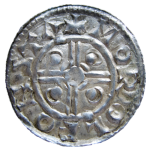
● Next Meeting Status:
Cancelled



● Host Society for the
BANS 2011 Congress
held in Southport


Enigmatic Canute?
Two Enigmatic Marks On A Penny Of King Canute (or Cnut!)
Canute, or Cnut, the son of Sweyn Forkbeard, King of Denmark, and his wife Saum-
The English Witan refused to accept Cnut’s elevation and instead restored the former King, Ethelred the Unready, precipitating a series of battles with the Danes. Ethelred died in 1016 and, although resistance to the Vikings continued under his son Edmund Ironside, Cnut succeeded in imposing his rule upon all England not long after. He consolidated his position by marrying Ethelred’s widow, Emma of Normandy, in July 1017.

In 1018, Cnut received the very last payment of Danegeld, £82,500 – much of which was levied on the citizens of London – and Cnut felt sufficiently secure to send home the Danish fleet with £72,000 that same year.
Although it has been said that Cnut undertook a reform of the English coinage, with
pennies issued to conform with the standards obtaining in Denmark, there is considerable
fluctuation in the sizes and weights of his coins. Three main types of pennies were
issued during Cnut’s lifetime: the Quatrefoil type with a crowned bust facing left,
with a sub-
A fourth type, with a Jewelled Cross, is considered to have been issued by Cnut’s widow, after his death in 1035.

The coin which is the subject of this note is from the Pointed Helmet issue, thought to have been struck in the period 1024 to 1030. The reverse shows the moneyer and mint as MOROLF ON STA, attributed to Morolf or Morulf of Stamford. The obverse is as usual for these coins, giving Cnut’s title as CNVT REX A and showing the portrait of the king facing left, and wearing a pointed helmet.
So far we have a fairly straightforward coin, if in extremely presentable condition. But there are two enigmas, which occur in the form of unusual marks or symbols which have been engraved, apparently quite deliberately, on the obverse die.

The more remarkable of the two is found on the king’s neck and breast. Close examination shows that an ‘X’ or saltire cross appears in relief on the coin. The form of this mark suggests that it could not have occurred by accident or be due to damage on the die, and it occurs in an area of the design which is normally devoid of any remotely similar angular features.

The second enigmatic mark is much more ordinary in appearance, being no more than a large stop or pellet which appears between the initial cross and the first letter of the king's name in the obverse legend.

Marks such as these are known from a few specimens of Cnut's coinage, and for some reason they seem to occur mostly (or entirely?) on examples from East Anglian mints. Assuming that the marks were placed deliberately what were their purposes? Were they a form of privy mark, to identify the particular die, or were they issue marks, or did they identify the mint or the engraver?
There seems to be no generally accepted view, and no categoric answer can yet be given. As is so often the case in numismatics, more information is needed. It would be useful to analyse details of as many examples as possible, and to this end any collector reading this note who has specimens of Cnut's coinage is invited to send reports to David Regan using our feedback form. Please click on the scroll, and we will take you straight there.

Send Us A Message

Where to next?

To help build up a picture of the usage of such marks, reports should include the
type of the coin, the moneyer and the mint, the nature and location of any unusual
marks, and illustrations if possible. Equally useful are reports of coins which
do NOT show any enigmatic marks. The analysis of the information will concentrate
on which mints appear to use enigmatic marks, on which types of coins, and for which
moneyers. From this, hopefully, a pattern will emerge as to whether the same type
of coin appears with, and without, marks from each mint, and similarly whether each
moneyer uses, or does not use, marks, or combines usage and non-
Collectors or students with views or suggestions on the use of such marks are invited to make contact and hopefully this page will be used to reflect any ongoing discussions or theories.
David M Regan


Hover your cursor to
see the coins in detail


